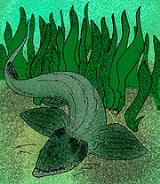
Pseudopetalichthyida
Encyclopedia
The Pseudopetalichthyida was a group of extinct, skate-like fishes known only from rare fossils in Lower Devonian strata in Hunsrück
, Germany. Like Stensioella heintzi
, and the Rhenanida
, the Pseudopetalichthids had armor made up of a mosaic of tubercles. Like Stensioella heintzi
, the Pseudopetalichthids' placement within Placodermi
is suspect. However, due to a gross lack of whole, uncrushed, articulated specimens, there are no other groups that the Pseudopetalichthids could be, for a lack of a better word, pigeonholed into.
On the other hand, according to anatomical studies done on the crushed specimens that have been found, those experts who do regard the Pseudopetalichthyida as placoderms consider them to be a group more advanced than the Ptyctodonts. And as such, pro-placoderm experts consider Pseudopetalichthyida to be the sister group of the Arthrodires + Phyllolepida
+ Antiarchi
trichotomy
and the Acanthothoraci
+ Rhenanida
dichotomy
.
The best known, and aptly named species is Pseudopetalicthys problematica. Some experts have suggested that Paraplesiobatis heinrichsi is the same species as P. problematica, but, due to the specimens of the latter species being crushed in a different position than the specimen of the former species, the anatomies of the two forms appear different (Moy-Thomas & Miles). However, this problem will be resolved only with more specimens. The anatomy of the specimens of Nessariostoma granulosa are sufficiently different from the other two pseudopetalichthyids to be recognized as a separate species. N. granulosa bears a superficial resemblance to Stensioella heintzi
, and it was this resemblance that originally lead to the pseudopetalichthyids' grouping within Stensioellidae.
Hunsrück
The Hunsrück is a low mountain range in Rhineland-Palatinate, Germany. It is bounded by the river valleys of the Moselle , the Nahe , and the Rhine . The Hunsrück is continued by the Taunus mountains on the eastern side of the Rhine. In the north behind the Moselle it is continued by the Eifel...
, Germany. Like Stensioella heintzi
Stensioella heintzi
Stensioella heintzi was an enigmatic placoderm of arcane affinity. It is only known from the Lower Devonian Hunsrück slates of Germany, where the only specimens have been found....
, and the Rhenanida
Rhenanida
Rhenanida was an order of primitive, lightly armored placoderms. Unlike most other placoderms, the rhenanids' armor was made up of a mosaic of unfused scales and tubercles...
, the Pseudopetalichthids had armor made up of a mosaic of tubercles. Like Stensioella heintzi
Stensioella heintzi
Stensioella heintzi was an enigmatic placoderm of arcane affinity. It is only known from the Lower Devonian Hunsrück slates of Germany, where the only specimens have been found....
, the Pseudopetalichthids' placement within Placodermi
Placodermi
Placodermi is a class of armoured prehistoric fish, known from fossils, which lived from the late Silurian to the end of the Devonian Period. Their head and thorax were covered by articulated armoured plates and the rest of the body was scaled or naked, depending on the species. Placoderms were...
is suspect. However, due to a gross lack of whole, uncrushed, articulated specimens, there are no other groups that the Pseudopetalichthids could be, for a lack of a better word, pigeonholed into.
On the other hand, according to anatomical studies done on the crushed specimens that have been found, those experts who do regard the Pseudopetalichthyida as placoderms consider them to be a group more advanced than the Ptyctodonts. And as such, pro-placoderm experts consider Pseudopetalichthyida to be the sister group of the Arthrodires + Phyllolepida
Phyllolepida
The order Phyllolepida was an order of flattened placoderms found throughout the world, with fossils being found in Devonian strata. Like other flattened placoderms, the phyllolepids were bottom-dwelling predators that ambushed prey...
+ Antiarchi
Antiarchi
The Antiarchi were the 2nd most successful order of placoderms known, after the Arthrodira. The order's name was coined by Edward Drinker Cope, who, when examining some fossils that he thought were armored tunicates related to Chelysoma, mistakenly thought that the eye-hole was the mouth, and...
trichotomy
Trichotomy
In mathematics, the Law of Trichotomy states that every real number is either positive, negative, or zero. More generally, trichotomy is the property of an order relation...
and the Acanthothoraci
Acanthothoraci
-Description:The Acanthothoraci were a group of chimaera-like placoderms who were closely related to the rhenanid placoderms. Superficially, the acanthoracids resembled scaly chimaeras, lightly armored arthrodires, or heavily armored ptyctodonts...
+ Rhenanida
Rhenanida
Rhenanida was an order of primitive, lightly armored placoderms. Unlike most other placoderms, the rhenanids' armor was made up of a mosaic of unfused scales and tubercles...
dichotomy
Dichotomy
A dichotomy is any splitting of a whole into exactly two non-overlapping parts, meaning it is a procedure in which a whole is divided into two parts...
.
The best known, and aptly named species is Pseudopetalicthys problematica. Some experts have suggested that Paraplesiobatis heinrichsi is the same species as P. problematica, but, due to the specimens of the latter species being crushed in a different position than the specimen of the former species, the anatomies of the two forms appear different (Moy-Thomas & Miles). However, this problem will be resolved only with more specimens. The anatomy of the specimens of Nessariostoma granulosa are sufficiently different from the other two pseudopetalichthyids to be recognized as a separate species. N. granulosa bears a superficial resemblance to Stensioella heintzi
Stensioella heintzi
Stensioella heintzi was an enigmatic placoderm of arcane affinity. It is only known from the Lower Devonian Hunsrück slates of Germany, where the only specimens have been found....
, and it was this resemblance that originally lead to the pseudopetalichthyids' grouping within Stensioellidae.

